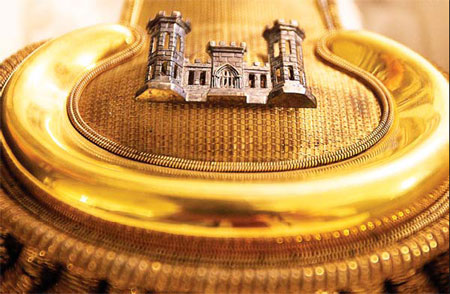Lee's sword returns to surrender site
Updated: 2012-03-26 08:09
By Associated Press in Richmond, Virginia (China Daily)
|
||||||||
|
A photo shows Thomas J. "Stonewall" Jackson's brass epaulets that he wore on formal occasions while a professor at the Virginia Military Institute in Richmond, Virginia. The sword Confederate General Robert E. Lee had at his side when he surrendered to Union General Ulysses S. Grant is returning to Appomattox, where it will be featured at a Civil War museum. [Dean Hoffmeyer / Richmond Times-Dispatch via Associated Press] |
The sword Confederate General Robert E. Lee had at his side when he surrendered to Union General Ulysses S. Grant is returning to Appomattox as the centerpiece of a new museum examining the post-Civil War struggle to heal the nation.
The uniform Lee wore that day in 1865 will also be on display on Saturday when the Museum of the Confederacy opens an 3,600-square-meter museum within 1.6 kilometers of where the war effectively ended.
The Appomattox museum is the first in a regional system planned by the Museum of the Confederacy to make its vast collection of Confederate artifacts and manuscripts more accessible. The Confederate States of America was the government set up from 1861-1865 by Southern states that supported slavery and seceded from the US.
Only about 10 percent of its holdings are on display at any one time at the Richmond museum, located next to the former Confederate White House. The other museums are planned for the Fredericksburg area and Hampton Roads, perhaps Fort Monroe.
All told, 454 uniforms, muskets, swords, documents, flags and other artifacts will be displayed at the Museum of the Confederacy-Appomattox. The town of Appomattox kicked in $350,000 for the $10 million project.
Waite Rawls, CEO and president of the Museum of the Confederacy, said the museum's message will reflect its location.
"Appomattox is one of those words you can say anywhere in the world and people know what you're talking about, like Waterloo," Rawls said. "Appomattox is the very metaphor for the end of the Civil War and the reunification of the nation."
The museum about 145 kilometers west of Richmond will chart the start of the war, its end and its impact on everyone from women to freed slaves.
In returning to Appomattox, Lee's French-made ceremonial sword is leaving its display in the Richmond museum after nearly a century.
The sword is seen at Lee's side in many paintings of the momentous meeting with Grant at Appomattox to sign the document of surrender on April 9, 1865. The Army of Northern Virginia's formal surrender followed three days later, effectively ending the war between the Northern and Southern states that left about 630,000 dead and led to the end of slavery.
It is an enduring myth, however, that Lee offered his sword to Grant, and that his Union counterpart refused the traditional gesture of surrender.
The sword has been freshly conserved after years of polishing had erased much of the golden luster from the brass. The nearly 1-meter sword now sparkles, from the lion head on its pommel to the gilded relief on its steel blade. It has an ivory grip.
The sword was intended for ceremonial use. There is no evidence Lee used it in battle.
The sword and scabbard, along with Lee's uniform, were given to the museum by the Confederate leader's descendants.
The Appomattox museum will complement the attractions at Appomattox Court House National Historical Park, said the park's historian, Patrick A. Schroeder. The 685-hectare park includes the McLean House, where Lee and Grant met April 9.
"We're pretty excited about it," Schroeder said. "It really gives people a reason to stay here."
Rawls is casting the museum as a stop for heritage tourists who can visit the national park as well as Poplar Forest, President Thomas Jefferson's retreat, Sailor's Creek state park, and even more contemporary attractions such as the National D-Day Memorial in Bedford County and the Robert Russa Moton Museum honoring the black scholar in Farmville. The latter chronicles the battle to integrate Virginia's public schools.
The sesquicentennial of the Civil War has increased visits to battlefields, including Appomattox and the Museum of the Confederacy in Richmond. While it has seen a 30 percent increase in attendance, the museum is difficult to find amid downtown high-rises.
"This is a bold step by us to take the museum where the people are, where tourists are going in growing numbers," Rawls said.
Virginia attracts approximately 6.5 million visitors annually to Civil War sites and battlefields such as the Wilderness and Petersburg's Battle of the Crater.
Civil War Trust president James Lighthizer said the Appomattox museum and the nearby battlefield help visitors make "physical connections to the past."

 Relief reaches isolated village
Relief reaches isolated village
 Rainfall poses new threats to quake-hit region
Rainfall poses new threats to quake-hit region
 Funerals begin for Boston bombing victims
Funerals begin for Boston bombing victims
 Quake takeaway from China's Air Force
Quake takeaway from China's Air Force
 Obama celebrates young inventors at science fair
Obama celebrates young inventors at science fair
 Earth Day marked around the world
Earth Day marked around the world
 Volunteer team helping students find sense of normalcy
Volunteer team helping students find sense of normalcy
 Ethnic groups quick to join rescue efforts
Ethnic groups quick to join rescue efforts
Most Viewed
Editor's Picks

|

|

|

|

|

|
Today's Top News
Health new priority for quake zone
Xi meets US top military officer
Japan's boats driven out of Diaoyu
China mulls online shopping legislation
Bird flu death toll rises to 22
Putin appoints new ambassador to China
Japanese ships blocked from Diaoyu Islands
Inspired by Guan, more Chinese pick up golf
US Weekly

|

|







